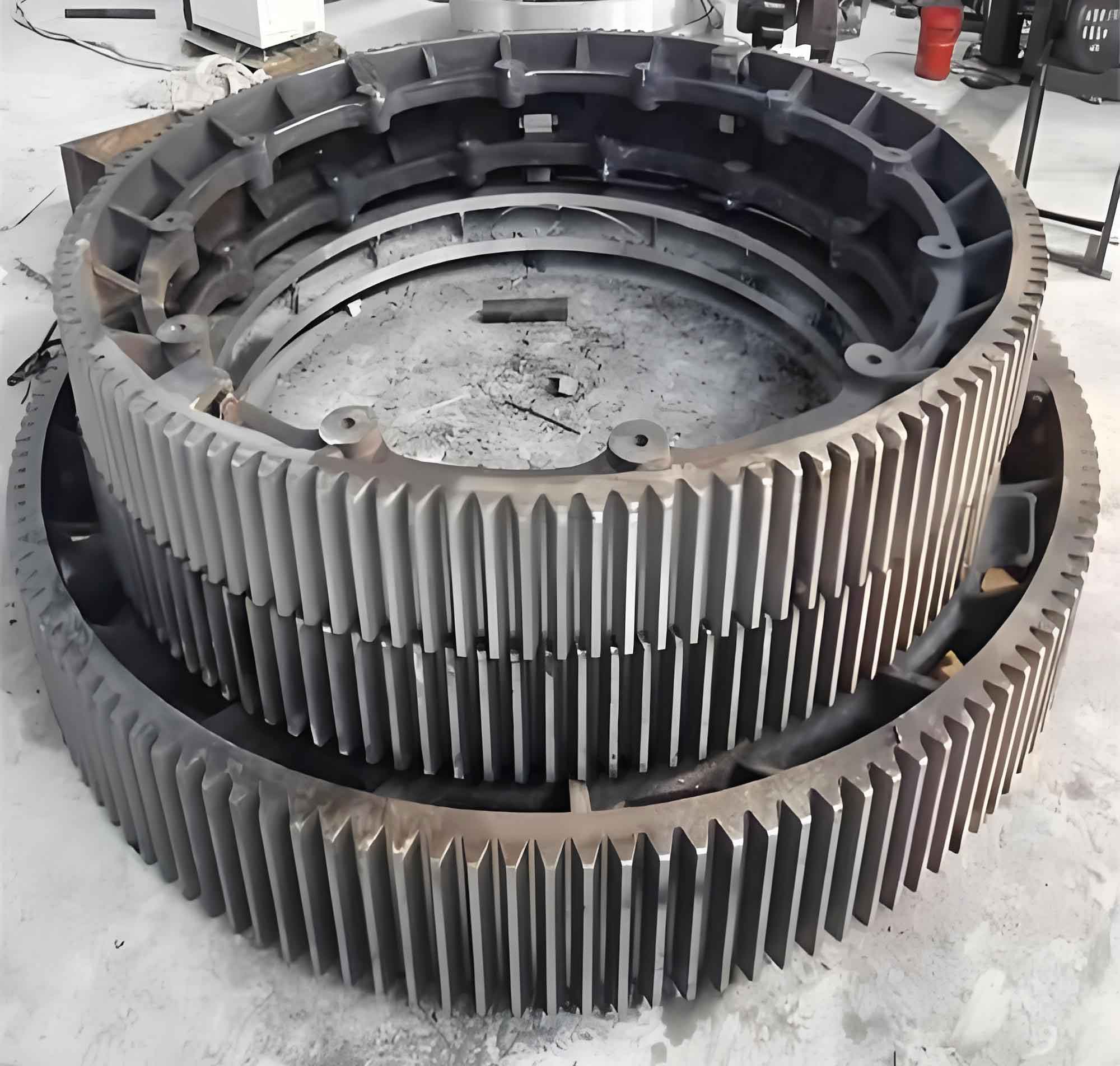Large gears are critical transmission components in mining mills, where reliability directly impacts operational safety and stability. As equipment specifications and power requirements increase, these gears now exceed 10 meters in diameter and approach 100 tons in weight. We’ve developed proprietary manufacturing technologies through rigorous optimization of material selection, casting, melting, and heat treatment processes. Our methodology ensures exceptional internal quality and mechanical performance under diverse operating conditions, establishing new industry benchmarks for large gear production.

Material Selection and Standards
Material selection for large gear components varies based on operational parameters and service conditions. We utilize specialized alloys including ZG42CrMo, ZG45CrMo, and our proprietary ZG40CrNi2Mo formulation engineered for high-stress mining applications. This proprietary alloy delivers optimal hardness distribution and fatigue resistance critical for large gear longevity. All materials conform to international standards:
| Standard Type | Applicable Standards |
|---|---|
| Design & Manufacturing | AGMA, ISO, ASTM, DIN |
| Ultrasonic Testing | ASTM A609 (Level 1 for tooth zone) |
| Magnetic Particle Inspection | ASTM E709 (≤5mm linear indications) |
Ultrasonic testing zones follow strict protocols where Zone A (tooth root +25.4mm) requires Level 1 sensitivity, while Zone B (remaining rim/flange) permits Level 2 indications. Our large gear production consistently achieves these stringent requirements through controlled chemistry:
$$[S] \leq 0.010\%,\quad [P] \leq 0.015\%$$
Casting Technology
Cast geometry optimization fundamentally determines large gear integrity. We employ integrated riser systems and computational simulation to ensure directional solidification. The transition from dispersed risers to annular configurations significantly enhanced feeding efficiency while maintaining yield rates. Solidification modeling governs padding design, where internal padding expands feeding channels according to:
$$\theta_c = \cos^{-1}\left(\frac{M_c}{M_r}\right)$$
where $\theta_c$ = feeding channel angle, $M_c$ = casting modulus, and $M_r$ = riser modulus. Comparative simulations demonstrate optimized thermal gradients with internal padding implementation:
| Padding Configuration | Solidification Time (hr) | Shrinkage Porosity Index |
|---|---|---|
| Without Padding | 18.7 | 0.42 |
| With Internal Padding | 21.3 | 0.09 |
Chill design enhances surface densification in critical tooth engagement zones. Sand-coated chills applied to the outer rim accelerate cooling, producing finer grain structures in high-stress regions. Our gating systems feature:
- Bottom-pour configurations minimizing turbulence
- Open-type systems enabling rapid pouring
- Multi-tiered designs for tall large gear profiles
Pattern construction combines physical models with precision core assemblies, while mold faces utilize chromite sand with zirconia coatings to withstand thermal shock.
Melting and Refining
Metallurgical control ensures homogeneity in massive large gear castings. Our triple-process refining achieves exceptional purity:
- Arc Furnace Primary Melting: Initial alloying with micro-additions
- LF Ladle Refining: Precise temperature/composition adjustment
- Vacuum Degassing: Hydrogen reduction to ≤1.5ppm
Protective protocols during pouring prevent reoxidation:
$$\ce{4[Al] + 3O2 -> 2Al2O3} \quad \Delta G^\circ = -1,582.3 + 0.535T\ kJ/mol$$
Argon shielding throughout the pouring process maintains low oxygen levels (<15ppm), crucial for minimizing non-metallic inclusions in thick-section large gear castings.
Heat Treatment
Thermal processing develops optimal microstructure throughout massive sections. Our two-stage protocol addresses distinct metallurgical objectives:
| Treatment Stage | Microstructural Transformation | Key Parameters |
|---|---|---|
| Annealing (Pre-Treatment) | Pearlite Formation | 890-910°C × 8hr + Furnace Cool |
| Quenching | Martensite Formation | 850-870°C × 10hr → Polymer Quench |
| Tempering | Tempered Martensite | 580-620°C × 24hr → Air Cool |
The quenching process follows the Grossmann equation for hardenability optimization:
$$DI = f(\%C) \times f(\%Mn) \times f(\%Cr) \times …$$
where DI = ideal critical diameter. Post-treatment hardness uniformity remains within Δ30 HB across large gear sections, while dimensional stability achieves <10mm distortion on 13m diameter components.
Implementation and Results
Our manufacturing system has produced over 1,500 mining mill gears including record-setting components like the Ø13,609mm gear for Φ11m×6.4m semi-autogenous mills. Global deployment statistics confirm reliability:
| Performance Metric | Value |
|---|---|
| Domestic Market Share | >85% |
| Global Deployment | 34 Countries |
| International Market Share | 23% |
| Service Life (Avg.) | >100,000 operational hours |
Continuous refinement of riser geometry, padding configuration, and thermal processing has elevated large gear performance benchmarks, particularly in extreme mineral processing environments.
Conclusion
Three technological pillars enable superior large gear manufacturing: 1) Directional solidification via optimized riser/padding systems validated through thermal modeling 2) Extreme purity metallurgy through triple-refining and atmospheric control 3) Precision thermal processing creating uniform tempered martensite structures. The integrated approach delivers components with exceptional fatigue resistance and dimensional stability, satisfying the escalating demands of modern mining operations. Future developments focus on computational material design for next-generation large gear applications exceeding current size and power thresholds.
